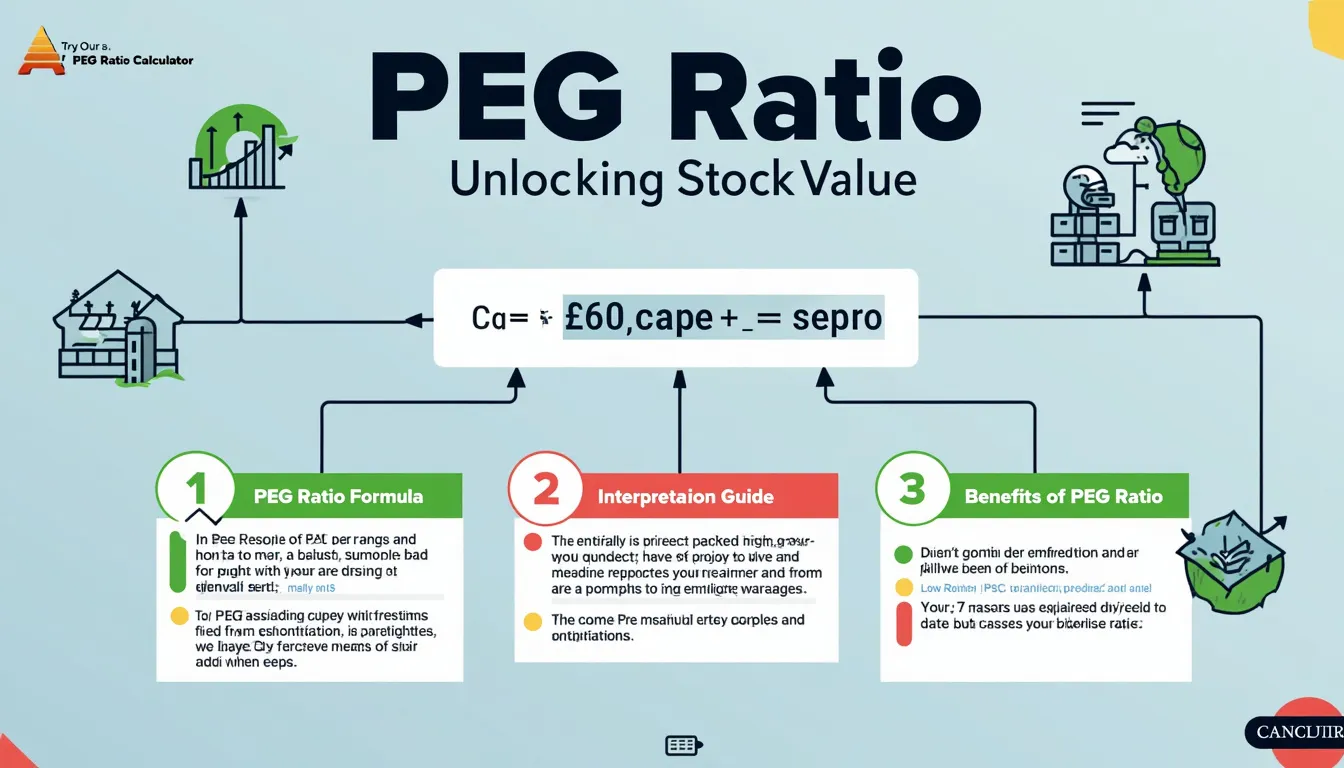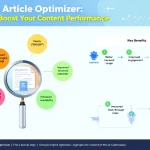PEG Ratio Calculator
Is this tool helpful?
Welcome to our comprehensive guide on the PEG Ratio Calculator, a powerful tool designed to help investors make informed decisions about stock valuations. In this article, we’ll explore the intricacies of the Price/Earnings to Growth (PEG) ratio, how to use our calculator effectively, and why it’s an essential metric for both novice and experienced investors alike.
How to Use the PEG Ratio Calculator Effectively
Our user-friendly PEG Ratio Calculator is designed to simplify the process of evaluating stock valuations. Here’s a step-by-step guide on how to use it effectively:
- Enter the Price/Earnings (P/E) Ratio: Input the current P/E ratio of the stock you’re analyzing. This information can typically be found on financial websites or in company reports.
- Input the Earnings Growth Rate: Enter the expected annual earnings growth rate as a percentage. This figure is often based on analysts’ projections or the company’s historical growth trends.
- Click “Calculate PEG Ratio”: Once you’ve entered both values, simply click the button to generate your result.
- Interpret the Results: The calculator will display the PEG ratio along with a brief interpretation to help you understand what the number means.
Remember, the PEG ratio is just one tool in an investor’s arsenal. It should be used in conjunction with other financial metrics and thorough research for a comprehensive analysis.
Understanding the PEG Ratio: Definition, Purpose, and Benefits
The Price/Earnings to Growth (PEG) ratio is a valuation metric that goes beyond the traditional Price/Earnings (P/E) ratio by factoring in a company’s expected earnings growth. It provides investors with a more nuanced view of a stock’s value, especially when comparing companies with different growth rates.
The PEG Ratio Formula
The PEG ratio is calculated using the following formula:
$$PEG\,Ratio = \frac{Price/Earnings\,Ratio}{Annual\,Earnings\,Growth\,Rate}$$In mathematical notation, this can be expressed as:
$$PEG = \frac{P/E}{g}$$Where:
- ((P/E\)) is the Price/Earnings ratio
- ((g\)) is the expected annual earnings growth rate (as a percentage)
Purpose of the PEG Ratio
The primary purpose of the PEG ratio is to determine whether a stock is overvalued, undervalued, or fairly valued, taking into account both its current price and its expected growth. This makes it particularly useful for comparing stocks across different industries or growth stages.
Benefits of Using the PEG Ratio
- Growth Consideration: Unlike the P/E ratio, the PEG ratio factors in a company’s growth prospects, providing a more forward-looking valuation metric.
- Comparative Analysis: It allows for easier comparison between companies with different growth rates, making it valuable for portfolio diversification.
- Value Identification: The PEG ratio can help identify potentially undervalued stocks that have strong growth prospects but are currently trading at lower multiples.
- Risk Assessment: By considering growth, the PEG ratio can highlight stocks that might be overvalued despite having attractive P/E ratios.
Benefits of Using Our PEG Ratio Calculator
Our PEG Ratio Calculator offers several advantages for investors and financial analysts:
- Time-Saving: Quickly compute PEG ratios without the need for manual calculations, allowing you to analyze multiple stocks efficiently.
- Accuracy: Eliminate human error in calculations, ensuring precise results every time.
- User-Friendly Interface: Our intuitive design makes it easy for users of all experience levels to input data and interpret results.
- Instant Interpretation: Receive immediate feedback on whether a stock might be undervalued, overvalued, or fairly valued based on its PEG ratio.
- Educational Tool: Learn about stock valuation metrics through practical application, enhancing your investment knowledge.
- Mobile Accessibility: Access the calculator on-the-go, making it convenient for quick analyses during market hours.
- Data Persistence: Your inputs are saved locally, allowing you to revisit and adjust your calculations easily.
Addressing User Needs: How the PEG Ratio Calculator Solves Specific Problems
Our PEG Ratio Calculator addresses several key challenges faced by investors:
1. Simplifying Complex Calculations
Many investors find financial ratios intimidating due to the calculations involved. Our calculator eliminates this barrier by automating the process, allowing users to focus on interpreting the results rather than struggling with the math.
2. Providing Context for P/E Ratios
While P/E ratios are widely used, they don’t tell the whole story. The PEG ratio adds crucial context by factoring in growth expectations, helping investors avoid the pitfall of overpaying for stocks with high P/E ratios but limited growth prospects.
3. Facilitating Comparative Analysis
Comparing stocks across different sectors or growth stages can be challenging. The PEG ratio provides a standardized metric that allows for more meaningful comparisons, helping investors make more informed decisions when diversifying their portfolios.
4. Identifying Potential Value Traps
Stocks with low P/E ratios might appear attractive at first glance but could be value traps if they have poor growth prospects. The PEG ratio helps investors identify these potential pitfalls by considering both current valuation and future growth.
5. Enhancing Investment Strategy
By providing a more nuanced view of stock valuations, our PEG Ratio Calculator empowers investors to refine their investment strategies. It can help in identifying growth stocks that are trading at reasonable valuations, potentially leading to better long-term returns.
Practical Applications: Examples and Use Cases
To illustrate the practical applications of the PEG Ratio Calculator, let’s explore some real-world scenarios:
Example 1: Comparing Tech Giants
Suppose you’re considering investing in two tech companies:
- Company A: P/E ratio of 30, expected earnings growth rate of 20%
- Company B: P/E ratio of 40, expected earnings growth rate of 30%
Using our calculator:
- Company A PEG Ratio: 30 / 20 = 1.5
- Company B PEG Ratio: 40 / 30 = 1.33
Despite having a higher P/E ratio, Company B actually has a lower PEG ratio, suggesting it might be a better value considering its higher growth rate.
Example 2: Evaluating a Value Stock
Consider a mature company in a stable industry:
- P/E ratio: 12
- Expected earnings growth rate: 5%
PEG Ratio: 12 / 5 = 2.4
While the low P/E ratio might make this stock appear attractive, the high PEG ratio suggests it might be overvalued relative to its modest growth prospects.
Example 3: Analyzing a High-Growth Stock
For a rapidly growing company in an emerging sector:
- P/E ratio: 60
- Expected earnings growth rate: 50%
PEG Ratio: 60 / 50 = 1.2
Despite the high P/E ratio, the PEG ratio suggests this stock might actually be reasonably valued given its exceptional growth rate.
Frequently Asked Questions (FAQ)
1. What is considered a good PEG ratio?
Generally, a PEG ratio below 1 is considered potentially undervalued, while a ratio above 1 might indicate overvaluation. However, “good” can vary by industry and market conditions. A PEG ratio around 1 is often seen as fairly valued.
2. Can the PEG ratio be negative?
While mathematically possible if a company has negative earnings growth projections, a negative PEG ratio is not meaningful for valuation purposes. It’s best to avoid using the PEG ratio for companies with negative growth expectations.
3. How accurate is the PEG ratio for long-term investing?
The PEG ratio can be a useful tool for long-term investing, but its accuracy depends on the reliability of earnings growth projections. It’s most effective when used in conjunction with other financial metrics and thorough company analysis.
4. Should I use trailing or forward P/E ratios for PEG calculations?
Both can be used, but forward P/E ratios are often preferred as they align better with future growth expectations. However, forward P/E ratios are based on estimates and may be less reliable than trailing figures.
5. How often should I recalculate the PEG ratio for stocks in my portfolio?
It’s a good practice to recalculate PEG ratios quarterly or at least annually, especially after earnings reports or when there are significant changes in a company’s growth outlook.
6. Can the PEG ratio be used for all types of companies?
While widely applicable, the PEG ratio is most useful for companies with positive earnings and growth. It may be less relevant for early-stage companies with negative earnings or those in highly cyclical industries.
7. How does the PEG ratio compare to other valuation metrics?
The PEG ratio complements other metrics like P/E, P/B, and DCF analysis. It’s particularly useful for growth stock analysis but should be used alongside other tools for a comprehensive valuation.
8. Are there limitations to using the PEG ratio?
Yes, the PEG ratio relies heavily on growth projections, which can be uncertain. It also doesn’t account for factors like dividend yield, debt levels, or industry-specific considerations.
9. Can I use the PEG ratio for international stock comparisons?
Yes, the PEG ratio can be useful for comparing stocks across different countries. However, be mindful of varying accounting standards and economic conditions that might affect growth projections.
10. How do market conditions affect PEG ratio interpretations?
In bull markets, investors might accept higher PEG ratios, while in bear markets, lower ratios might be expected. Always consider broader market trends when interpreting PEG ratios.
Disclaimer: While we strive for accuracy, we cannot guarantee that the results from our PEG Ratio Calculator are always correct, complete, or reliable. Our content and tools may contain errors, biases, or inconsistencies. Always use this calculator in conjunction with other research and professional financial advice for making investment decisions.
Conclusion: Harnessing the Power of the PEG Ratio
The PEG Ratio Calculator is an invaluable tool for investors seeking to make more informed decisions about stock valuations. By combining the simplicity of the P/E ratio with the forward-looking aspect of earnings growth, the PEG ratio provides a more comprehensive picture of a stock’s potential value.
Key benefits of using our PEG Ratio Calculator include:
- Quick and accurate calculations
- Enhanced comparative analysis capabilities
- Improved identification of potentially under- or overvalued stocks
- Better understanding of the relationship between price, earnings, and growth
- A valuable addition to your investment research toolkit
Remember, while the PEG ratio is a powerful metric, it should not be used in isolation. Combine it with thorough company research, industry analysis, and other financial metrics to build a well-rounded investment strategy.
We encourage you to bookmark our PEG Ratio Calculator and make it a regular part of your investment analysis process. By doing so, you’ll be better equipped to navigate the complex world of stock valuation and potentially identify lucrative investment opportunities.
Start using our PEG Ratio Calculator today and take the first step towards more informed, growth-oriented investment decisions!
Important Disclaimer
The calculations, results, and content provided by our tools are not guaranteed to be accurate, complete, or reliable. Users are responsible for verifying and interpreting the results. Our content and tools may contain errors, biases, or inconsistencies. We reserve the right to save inputs and outputs from our tools for the purposes of error debugging, bias identification, and performance improvement. External companies providing AI models used in our tools may also save and process data in accordance with their own policies. By using our tools, you consent to this data collection and processing. We reserve the right to limit the usage of our tools based on current usability factors. By using our tools, you acknowledge that you have read, understood, and agreed to this disclaimer. You accept the inherent risks and limitations associated with the use of our tools and services.







